How iron-fisted was pharaonic rule in the city-states of Syria-Palestine?
In the centuries before Israel emerged in the highlands of Canaan, first as a people and then as a nation, the region was essentially ruled by Egypt. But how are we to understand this hegemony?
Until a little more than a century ago, about the only source of information we had regarding Egyptian-Canaanite relations was the Bible. In 1887, however, a female peasant made a stupendous discovery at a site in Egypt called Tell el-Amarna. Digging up decayed mudbricks for fertilizer, she unearthed a cache of cuneiforma tablets. Since such tablets had never before been found in Egypt, scholars were initially skeptical of their authenticity. Nevertheless, the tablets were peddled to those antiquities dealers, scholars and museum curators who were interested in them.
Once the tablets were determined to be genuine, archaeologists began excavating the site. Known in ancient times as Akhetaten, “the Horizon of (the god) Aten,” Amarna was the capital of Pharaoh Akhenaten’s empire. Akhenaten (1348–1331 B.C.E.), the so-called “heretic” king, broke with Egyptian religious tradition and exclusively worshiped Aten, who is represented in Egyptian art by the sun disk with its myriad rays ending in hands.
Read the rest of The Egyptianizing of Canaan in the online Biblical Archaeology Society Library.
